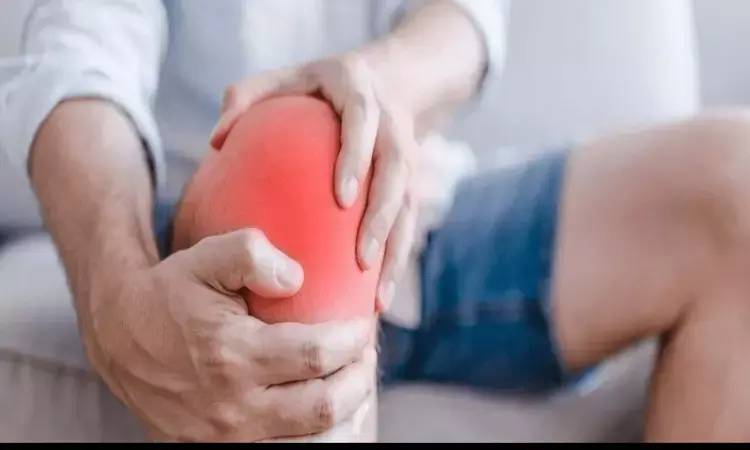- Home
- Medical news & Guidelines
- Anesthesiology
- Cardiology and CTVS
- Critical Care
- Dentistry
- Dermatology
- Diabetes and Endocrinology
- ENT
- Gastroenterology
- Medicine
- Nephrology
- Neurology
- Obstretics-Gynaecology
- Oncology
- Ophthalmology
- Orthopaedics
- Pediatrics-Neonatology
- Psychiatry
- Pulmonology
- Radiology
- Surgery
- Urology
- Laboratory Medicine
- Diet
- Nursing
- Paramedical
- Physiotherapy
- Health news
- Fact Check
- Bone Health Fact Check
- Brain Health Fact Check
- Cancer Related Fact Check
- Child Care Fact Check
- Dental and oral health fact check
- Diabetes and metabolic health fact check
- Diet and Nutrition Fact Check
- Eye and ENT Care Fact Check
- Fitness fact check
- Gut health fact check
- Heart health fact check
- Kidney health fact check
- Medical education fact check
- Men's health fact check
- Respiratory fact check
- Skin and hair care fact check
- Vaccine and Immunization fact check
- Women's health fact check
- AYUSH
- State News
- Andaman and Nicobar Islands
- Andhra Pradesh
- Arunachal Pradesh
- Assam
- Bihar
- Chandigarh
- Chattisgarh
- Dadra and Nagar Haveli
- Daman and Diu
- Delhi
- Goa
- Gujarat
- Haryana
- Himachal Pradesh
- Jammu & Kashmir
- Jharkhand
- Karnataka
- Kerala
- Ladakh
- Lakshadweep
- Madhya Pradesh
- Maharashtra
- Manipur
- Meghalaya
- Mizoram
- Nagaland
- Odisha
- Puducherry
- Punjab
- Rajasthan
- Sikkim
- Tamil Nadu
- Telangana
- Tripura
- Uttar Pradesh
- Uttrakhand
- West Bengal
- Medical Education
- Industry
Home-based rehabilitation suitable for recovery after arthroscopic isolated meniscectomy

Researchers have recently highlighted the fact that home-based rehabilitation (HBP) may be an effective management approach after arthroscopic isolated meniscectomy (AM) in the general population, according to the study published in the JAMA Open Network.
rthroscopic meniscectomy is one of the most common orthopedic procedures. The optimal postoperative approach remains debated.
Hence, Sebastiano Nutarelli and colleagues from the Orthopaedic and Traumatology Unit, Ospedale Regionale di Lugano, EOC, Lugano, Switzerland carried out the present study to compare outcomes associated with home-based rehabilitation programs (HBP) vs standard inpatient and/or outpatient supervised physical therapy (IOP) following arthroscopic isolated meniscectomy (AM).
A systematic literature search was conducted and randomized clinical trials of patients treated with HBP vs IOP after AM were included for the research. The primary outcome was the Lysholm score (scale of 0-100 with higher scores indicating better knee function) and secondary outcomes were subjective International Knee Documentation Committee (IKDC) score, knee extension and flexion, thigh girth, horizontal and vertical hop test, and days to return to work, as indicated in the PROSPERO registration. Outcomes were measured in the short-term (ranging from 28 to 50 days) and the midterm (6 months).
The following results were posted-
- In this meta-analysis of 8 RCTs including 434 patients, IOP was associated with a greater short-term improvement in Lysholm score compared with HBP, with a mean difference of −8.64 points (95% CI, −15.14 to −2.13 points; P = .02) between the 2 approached, but the sensitivity analysis showed no difference.
- Similarly, no statistically significant difference was detected at midterm for Lysholm score, with a mean difference between groups of −4.78 points (95% CI, −9.98 to 0.42 points; P = .07).
- HBP was associated with a greater short-term improvement in thigh girth, with a mean difference between groups of 1.38 cm (95% CI, 0.27 to 2.48 cm; P = .01), whereas IOP was associated with a better short-term vertical hop score, with a mean difference between groups of −3.25 cm (95% CI, −6.20 to −0.29 cm; P = .03).
- No differences were found for all the other secondary outcomes.
Therefore, the authors concluded that "no intervention was found to be superior in terms of physical and functional outcomes as well as work-related and patient-reported outcomes, both at short-term and midterm follow-up. Overall, these results suggest that HBP may be an effective management approach after AM in the general population."
Dr. Nandita Mohan is a practicing pediatric dentist with more than 5 years of clinical work experience. Along with this, she is equally interested in keeping herself up to date about the latest developments in the field of medicine and dentistry which is the driving force for her to be in association with Medical Dialogues. She also has her name attached with many publications; both national and international. She has pursued her BDS from Rajiv Gandhi University of Health Sciences, Bangalore and later went to enter her dream specialty (MDS) in the Department of Pedodontics and Preventive Dentistry from Pt. B.D. Sharma University of Health Sciences. Through all the years of experience, her core interest in learning something new has never stopped. She can be contacted at editorial@medicaldialogues.in. Contact no. 011-43720751
Dr Kamal Kant Kohli-MBBS, DTCD- a chest specialist with more than 30 years of practice and a flair for writing clinical articles, Dr Kamal Kant Kohli joined Medical Dialogues as a Chief Editor of Medical News. Besides writing articles, as an editor, he proofreads and verifies all the medical content published on Medical Dialogues including those coming from journals, studies,medical conferences,guidelines etc. Email: drkohli@medicaldialogues.in. Contact no. 011-43720751


